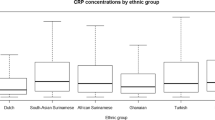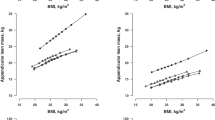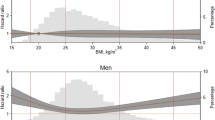Abstract
Background:
Ethnic disparities in metabolic disease risk may be the result of differences in circulating adipokines and inflammatory markers related to ethnic variations in obesity and body fat distribution.
Subjects/Methods:
In a cross-sectional design, we compared serum levels of leptin, adiponectin, C-reactive protein (CRP), interleukin-6 (IL-6) and tumor necrosis factor-α (TNF-α) in control subjects (321 men and 930 women) from two nested case–control studies conducted within the Multiethnic Cohort Study consisting of whites, Japanese Americans (JA), Latinos, African Americans (AA) and Native Hawaiians (NH). General linear models were applied to evaluate ethnic differences in log-transformed serum biomarker levels before and after adjusting for body mass index (BMI) at cohort entry.
Results:
In comparison to whites, significant ethnic differences were observed for all biomarkers except TNF-α. JA men and women had significantly lower leptin and CRP levels than whites, and JA women also had lower adiponectin levels. Leptin was significantly higher in AA women (P<0.01), adiponectin was significantly lower in AA men and women (P=0.02 and P<0.001), and CRP and IL-6 were significantly higher in AA men and women. Lower adiponectin (P<0.0001) and CRP (P=0.03) levels were the only biomarkers in NH women that differed from whites; no statistically significant differences were seen for NH men and for Latino men and women. When adjusted for BMI at cohort entry, the differences between the lowest and the highest values across ethnic groups decreased for all biomarkers except adiponectin in men indicating that ethnic differences were partially due to weight status.
Conclusions:
These findings demonstrate the ethnic variations in circulating adipokine and CRP levels before and after adjustment for BMI. Given the limitation of BMI as a general measure of obesity, further investigation with visceral and subcutaneous adiposity measures are warranted to elucidate ethnicity-related differences in adiposity in relation to disparities in obesity-related disease risk.
This is a preview of subscription content, access via your institution
Access options
Subscribe to this journal
Receive 12 print issues and online access
$259.00 per year
only $21.58 per issue
Buy this article
- Purchase on Springer Link
- Instant access to full article PDF
Prices may be subject to local taxes which are calculated during checkout


Similar content being viewed by others
References
Fujimoto WY . The importance of insulin resistance in the pathogenesis of type 2 diabetes mellitus. Am J Med 2000; 108: 9S–14S.
Yehuda-Shnaidman E, Schwartz B . Mechanisms linking obesity, inflammation and altered metabolism to colon carcinogenesis. Obes Rev 2012; 13: 1083–1095.
Rose DP, Haffner SM, Baillargeon J . Adiposity, the metabolic syndrome, and breast cancer in African-American and white American women. Endocr Rev 2007; 28: 763–777.
Fantuzzi G . Adipose tissue, adipokines, and inflammation. J Allergy Clin Immunol 2005; 115: 911–919.
Harford KA, Reynolds CM, McGillicuddy FC, Roche HM . Fats inflammation and insulin resistance: insights to the role of macrophage and T-cell accumulation in adipose tissue. Proc Nutr Soc 2011; 70: 408–417.
Bulcao C, Ferreira SR, Giuffrida FM, Ribeiro-Filho FF . The new adipose tissue and adipocytokines. Curr Diabetes Rev 2006; 2: 19–28.
Hocking S, Samocha-Bonet D, Milner KL, Greenfield JR, Chisholm DJ . Adiposity and Insulin Resistance in Humans: The Role of the Different Tissue and Cellular Lipid Depots. Endocr Rev 2013; 34: 463–500.
Patel PS, Buras ED, Balasubramanyam A . The role of the immune system in obesity and insulin resistance. J Obes 2013; 2013: 616193.
Geer EB, Shen W . Gender differences in insulin resistance, body composition, and energy balance. Gend Med 2009; 6: 60–75.
Conroy SM, Chai W, Lim U, Franke AA, Cooney RV, Maskarinec G . Leptin, Adiponectin, and Obesity among Caucasian and Asian Women. Mediators Inflamm 2011; 2011: 253580.
Lim U, Ernst T, Buchthal SD, Latch M, Albright CL, Wilkens LR et al. Asian women have greater abdominal and visceral adiposity than Caucasian women with similar body mass index. Nutr Diabetes 2011; 1: e6.
Carroll JF, Fulda KG, Chiapa AL, Rodriquez M, Phelps DR, Cardarelli KM et al. Impact of race/ethnicity on the relationship between visceral fat and inflammatory biomarkers. Obesity (Silver Spring) 2009; 17: 1420–1427.
Maskarinec G, Erber E, Grandinetti A, Verheus M, Oum R, Hopping BN et al. Diabetes incidence based on linkages with health plans: the multiethnic cohort. Diabetes 2009; 58: 1732–1738.
Resnick HE, Valsania P, Halter JB, Lin X . Differential effects of BMI on diabetes risk among black and white Americans. Diabetes Care 1998; 21: 1828–1835.
Kolonel LN, Henderson BE, Hankin JH, Nomura AM, Wilkens LR, Pike MC et al. A multiethnic cohort in Hawaii and Los Angeles: baseline characteristics. Am J Epidemiol 2000; 151: 346–357.
Ollberding NJ, Kim Y, Shvetsov YB, Wilkens LR, Franke AA, Cooney RV et al. Prediagnostic leptin, adiponectin, C-reactive protein, and the risk of postmenopausal breast cancer. Cancer Prev Res (Phila) 2013; 6: 188–195.
Morimoto Y, Conroy SM, Ollberding NJ, Henning SM, Franke AA, Wilkens LR et al. Erythrocyte membrane fatty acid composition, serum lipids, and non-Hodgkin's lymphoma risk in a nested case-control study: the multiethnic cohort. Cancer Causes Control 2012; 23: 1693–1703.
Park SY, Wilkens LR, Henning SM, Le ML, Gao K, Goodman MT et al. Circulating fatty acids and prostate cancer risk in a nested case-control study: the Multiethnic Cohort. Cancer Causes Control 2009; 20: 211–223.
Conroy SM, Maskarinec G, Morimoto Y, Franke AA, Cooney RV, Wilkens LR et al. Non-hodgkin lymphoma and circulating markers of inflammation and adiposity in a nested case-control study: the multiethnic cohort. Cancer Epidemiol Biomarkers Prev 2013; 22: 337–347.
Khan UI, Wang D, Sowers MR, Mancuso P, Everson-Rose SA, Scherer PE et al. Race-ethnic differences in adipokine levels: the Study of Women's Health Across the Nation (SWAN). Metabolism 2012; 61: 1261–1269.
Matsuzawa Y . Adiponectin: a key player in obesity related disorders. Curr Pharm Des 2010; 16: 1896–1901.
Kohli S, Sniderman AD, Tchernof A, Lear SA . Ethnic-specific differences in abdominal subcutaneous adipose tissuecompartments. Obesity (Silver Spring) 2010; 18: 2177–2183.
Anand SS, Tarnopolsky MA, Rashid S, Schulze KM, Desai D, Mente A et al. Adipocyte hypertrophy, fatty liver and metabolic risk factors in South Asians: the Molecular Study of Health and Risk in Ethnic Groups (mol-SHARE). PLoS One 2011; 6: e22112.
Azuma K, Curb JD, Kadowaki T, Edmundowicz D, Kadowaki S, Masaki KH et al. Ethnic difference in liver fat content: a cross-sectional observation among Japanese American in Hawaii, Japanese in Japan, and non-Hispanic whites in United States. Obes Res Clin Pract 2013; 7: e198–e205.
Lara-Castro C, Hunter GR, Lovejoy JC, Gower BA, Fernandez JR . Apolipoprotein A-II polymorphism and visceral adiposity in African-American and white women. Obes Res 2005; 13: 507–512.
Mente A, Meyre D, Lanktree MB, Heydarpour M, Davis AD, Miller R et al. Causal Relationship between Adiponectin and Metabolic Traits: A Mendelian Randomization Study in a Multiethnic Population. PLoS One 2013; 8: e66808.
Mente A, Razak F, Blankenberg S, Vuksan V, Davis AD, Miller R et al. Ethnic variation in adiponectin and leptin levels and their association with adiposity and insulin resistance. Diabetes Care 2010; 33: 1629–1634.
Lara-Castro C, Hunter GR, Lovejoy JC, Gower BA, Fernandez JR . Association of the intestinal fatty acid-binding protein Ala54Thr polymorphism and abdominal adipose tissue in African-American and Caucasian women. J Clin Endocrinol Metab 2005; 90: 1196–1201.
Rossi IA, Bochud M, Bovet P, Paccaud F, Waeber G, Vollenweider P et al. Sex difference and the role of leptin in the association between high-sensitivity C-reactive proteinand adiposity in two different populations. Eur J Epidemiol 2012; 27: 379–384.
Ruhl CE, Everhart JE, Ding J, Goodpaster BH, Kanaya AM, Simonsick EM et al. Serum leptin concentrations and body adipose measures in older black and white adults. Am J Clin Nutr 2004; 80: 576–583.
Lilja M, Rolandsson O, Shaw JE, Pauvaday V, Cameron AJ, Tuomilehto J et al. Higher leptin levels in Asian Indians than Creoles and Europids: a potential explanation for increased metabolic risk. Int J Obes (Lond) 2010; 34: 878–885.
Ruhl CE, Everhart JE . Leptin concentrations in the United States: relations with demographic and anthropometric measures. Am J Clin Nutr 2001; 74: 295–301.
Nakamura Y, Ueshima H, Okuda N, Miura K, Kita Y, Okamura T et al. Relation of dietary and lifestyle traits to difference in serum leptin of Japanese in Japan and Hawaii: the INTERLIPID study. Nutr Metab Cardiovasc Dis 2012; 22: 14–22.
Acknowledgements
The Multiethnic Cohort Study has been supported by grants R37 CA 54281, R01 CA 63464, P01 CA033619 and UM1 CA164973 from the National Cancer Institute (NCI). Partial support was also provided by the NCI grant P01 CA138338. SMC and NJO had been supported by Postdoctoral Training grant R25 CA 90956 from the NCI. The Analytical Biochemistry Shared Resource of the University of Hawaii Cancer Center is supported, in part, by grant P30 CA71789 from the NCI. We thank William Cooney and Jennifer Lai for their technical performance of serum biomarker assays.
Author information
Authors and Affiliations
Corresponding author
Ethics declarations
Competing interests
The authors declare no conflict of interest.
Additional information
Supplementary Information accompanies this paper on International Journal of Obesity website
Supplementary information
Rights and permissions
About this article
Cite this article
Morimoto, Y., Conroy, S., Ollberding, N. et al. Ethnic differences in serum adipokine and C-reactive protein levels: the multiethnic cohort. Int J Obes 38, 1416–1422 (2014). https://doi.org/10.1038/ijo.2014.25
Received:
Revised:
Accepted:
Published:
Issue Date:
DOI: https://doi.org/10.1038/ijo.2014.25
Keywords
This article is cited by
-
Sexual dimorphism of leptin and adiposity in children between 0 and 10 years: a systematic review and meta-analysis
Biology of Sex Differences (2022)
-
Genetic pleiotropy underpinning adiposity and inflammation in self-identified Hispanic/Latino populations
BMC Medical Genomics (2022)
-
Genome-wide analyses of multiple obesity-related cytokines and hormones informs biology of cardiometabolic traits
Genome Medicine (2021)
-
Elevated CRP even at the first visit to a rheumatologist is associated with long-term poor outcomes in patients with psoriatic arthritis
Clinical Rheumatology (2020)
-
The high risk for type 2 diabetes among ethnic minority populations is not explained by low-grade inflammation
Scientific Reports (2019)



